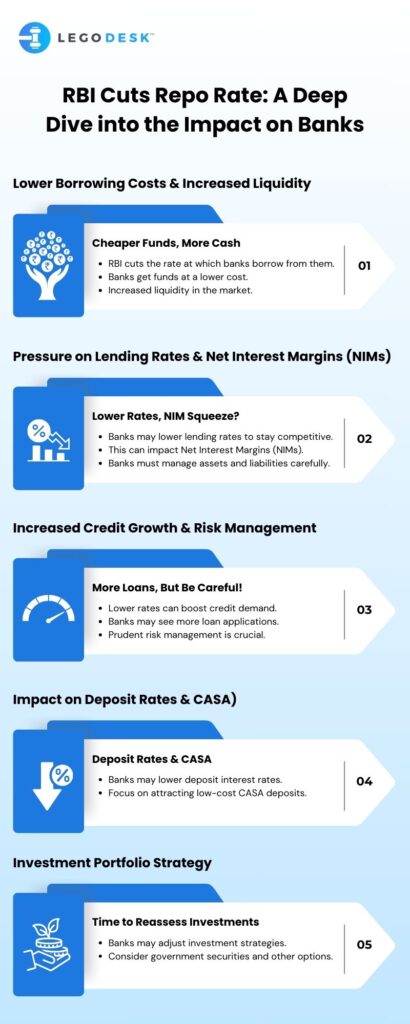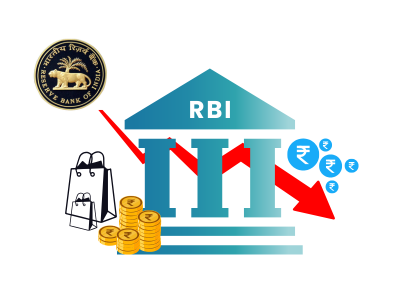RBI Cuts Repo Rate: What It Means for Banks and MSMEs
The Reserve Bank of India (RBI) has recently announced a cut in the repo rate, a move that reverberates throughout the Indian financial ecosystem. This decision, a key highlight of the latest RBI Monetary Policy Update, carries significant implications for banks, Micro, Small, and Medium Enterprises (MSMEs), and the broader economy. Let’s dissect what this RBI cuts repo rate announcement signifies for these crucial players, exploring the nuances and potential long-term effects.
RBI Cuts Repo Rate: Fueling Economic Growth?
The RBI cuts repo rate, the rate at which commercial banks borrow money from the RBI, by a specific basis point reduction (e.g., 25 basis points). This reduction is strategically designed to inject liquidity into the financial system and encourage lending activities. The central bank’s primary objective behind this RBI cuts repo rate decision is to stimulate economic activity. By making borrowing cheaper for banks, the RBI anticipates that they will pass on these lower costs to borrowers, thereby boosting investment and consumption. This RBI Monetary Policy Update often signals a potential shift towards a more accommodative monetary policy stance, although the central bank typically remains vigilant about inflationary pressures. The degree of the repo rate cut is a crucial indicator of the RBI’s assessment of the economic climate and its commitment to growth versus inflation control.
What RBI Cuts Repo Rate Means for Banks: A Deep Dive

The RBI cuts repo rate has a multifaceted and often complex impact on banks:
- Lower Borrowing Costs & Increased Liquidity: The most direct and immediate impact is the reduction in the cost of funds for banks. When the RBI cuts repo rate, banks can borrow money from the central bank at a cheaper rate. This directly reduces their overall cost of borrowing, improving their profitability. Furthermore, it increases the overall liquidity available in the market.
- Pressure on Lending Rates & Net Interest Margins (NIMs): This RBI cuts repo rate decision inevitably puts downward pressure on lending rates. Banks are likely to reduce the interest rates they charge on loans to remain competitive and attract borrowers in a lower-rate environment. This, in turn, can affect their net interest margins (NIMs), which represent the difference between the interest they earn on loans and the interest they pay on deposits. Banks need to carefully manage their asset-liability mix to maintain healthy NIMs in a scenario where the RBI cuts repo rate.
- Increased Credit Growth & Risk Management: With the RBI cuts repo rate, banks can potentially witness increased credit demand. Lower interest rates make borrowing more attractive for businesses and individuals, leading to a rise in loan applications and disbursements. This boost in credit growth is a key objective of the RBI Monetary Policy Update. However, banks need to be cautious about risk management and ensure that lending standards are not compromised in the pursuit of higher credit growth. A surge in lending without proper due diligence can lead to asset quality issues down the line.
- Impact on Deposit Rates & CASA: When the RBI cuts repo rate, banks may also lower the interest rates they offer on deposits to maintain their NIMs. This can impact the flow of funds into bank deposits. Banks will need to focus on attracting low-cost deposits, such as Current Account and Savings Account (CASA) deposits, to mitigate the impact on their profitability.
- Investment Portfolio Strategy: The RBI cuts repo rate also influences how banks manage their investment portfolios. They may choose to invest more in government securities or other fixed-income instruments depending on the prevailing market conditions and their overall risk appetite.
RBI Cuts Repo Rate: A Shot in the Arm for MSMEs? A Detailed Look
MSMEs, often considered the backbone of the Indian economy and significant contributors to job creation, stand to benefit significantly from the RBI cuts repo rate:
- Cheaper Access to Credit & Reduced Financial Burden: The RBI cuts repo rate should translate into lower interest rates on loans for MSMEs. This makes borrowing more affordable, allowing them to access the necessary funds for working capital, expansion, technology upgrades, and other crucial business needs. Access to affordable credit is paramount for the growth and survival of MSMEs, many of which struggle with funding constraints.
- Boost to Investment and Growth & Expansion Plans: Lower interest rates encourage MSMEs to invest in their businesses. With reduced borrowing costs, they are more likely to take on new projects, expand their operations, modernize their equipment, and create more jobs. This contributes significantly to overall economic growth and development. This is a key aim of the RBI Monetary Policy Update.
- Improved Cash Flows & Operational Efficiency: The RBI cuts repo rate and the subsequent reduction in lending rates can significantly improve the cash flows of MSMEs. Lower interest payments free up more funds for businesses to reinvest in their operations, pay wages, procure raw materials, and manage other essential expenses. This enhanced financial flexibility enables them to operate more efficiently.
- Enhanced Competitiveness & Market Access: Lower borrowing costs can enhance the competitiveness of MSMEs, both domestically and internationally. They can offer more competitive pricing on their products and services, allowing them to capture a larger market share and compete more effectively with larger enterprises. This is particularly important in today’s increasingly globalized marketplace.
- Mitigating the Impact of Economic Downturns: During periods of economic slowdown, the RBI cuts repo rate can act as a crucial buffer for MSMEs, helping them weather the storm and avoid financial distress. Lower interest rates can reduce their debt burden and make it easier for them to manage their finances during challenging times.
RBI Monetary Policy Update: A Delicate Balancing Act
This RBI Monetary Policy Update, featuring the RBI cuts repo rate, reflects the central bank’s ongoing efforts to strike a delicate balance between promoting economic growth and keeping inflation under control. While the RBI cuts repo rate is generally expected to stimulate economic activity, the RBI remains vigilant about inflationary pressures, particularly in a dynamic and evolving economic environment. The central bank will continue to monitor a wide range of macroeconomic indicators, including inflation, GDP growth, industrial production, and global economic trends, and adjust its policy stance as needed.
Conclusion: A Positive Impetus with Cautious Optimism
The RBI cuts repo rate is generally viewed as a positive development for both banks and MSMEs. For banks, it lowers borrowing costs and can potentially lead to increased credit growth, although they need to manage their NIMs and asset quality prudently. For MSMEs, it translates into cheaper access to credit, boosting investment, growth, competitiveness, and resilience. This RBI Monetary Policy Update signals a positive step towards supporting economic recovery and empowering MSMEs, a vital sector of the Indian economy. However, the impact of this RBI cuts repo rate decision will depend on a multitude of factors, including global economic conditions, domestic policy measures, and the overall business environment. While the RBI cuts repo rate provides a positive impetus, a cautious and pragmatic approach is essential for sustained economic growth and stability. Continuous monitoring and adaptive policy measures will be crucial in the months to come.

